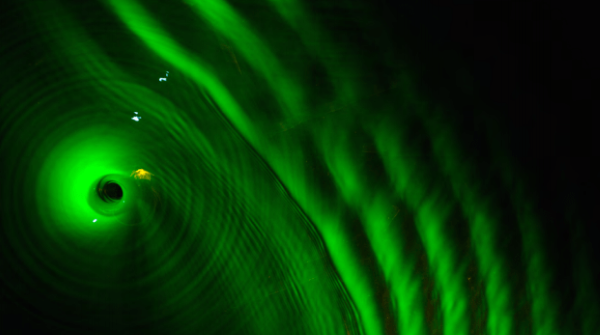
This thought-provoking look at the phenomena of black holes starts off in the mountains of Sardinia, where visitors don’t realize just how close to the atmosphere they are. That’s fitting, as a central theme of the documentary is that the profound and celestial aren’t beyond our grasp as we might have believed, thanks to certain parties’ efforts.
Director Peter Galison cuts back and forth between two endeavors, the first involving the Event Horizon Telescope (EHT) Project, in which radio telescopes at observatories around the world are set to simultaneously focus on the “nearest” black hole, which is nearly 26,000 light-years away. By doing so, they will act as a single telescope, which, according to Shep Doeleman, an astrophysicist at Harvard and the EHT’s founding director, is the only way to capture the details of something so far off in space.
The other project centers on theoretical physicists Stephen Hawking, Malcolm Perry, Andrew Strominger, and Sasha Haco, who are working together to resolve the black hole information paradox first introduced by Hawking in the mid-1970s. Building on his theory that black holes aren’t just vortexes in which everything, even light, disappears into, but that they also emit information, Hawking hypothesized that what emerged was essentially random. As his colleagues explain, this idea rocked the scientific world when first introduced, as it argued that the universe was not, in fact, governed by predictable physical laws.
The filmmaker interviews other various experts who explain what black holes are as well as their nature. (Wisely, Galison interviews no shortage of women and people of color, which proves a nice counterpoint to the mostly male, white subjects of the two main story lines.) Though there understandably isn’t much actual footage of black holes, the film makes up for it with whimsical and highly evocative animated sequences—one consists of a trail of figures curving around and around in a whirlpool until disappearing from view.
Galison also goes behind the scenes at various laboratories to highlight just how far humans have gone to study and re-create black holes, and in doing so, he sets up an interesting paradox of his own about them: they’re inherently fascinating and have long captured the human imagination, yet for all that, they are still highly enigmatic. Nevertheless, for neophytes who only know of them as enormous space vacuums, the film has its share of revelatory moments—for example, we hear gravitational waves of two black holes colliding in space, and the sound is riveting.
Though the film is full of jargon that may fly over viewers’ heads (it certainly did in my case), it remains accessible and easy to follow, thanks to how the filmmakers and subjects eschew explaining complicated mathematical formulas or scientific theories. In addition, despite constantly appealing to our brains, the film never misses opportunities to tug on our emotions through the camaraderie between Hawking and his colleagues—which endures even after his death in 2018—and among members of the EHT Project (though admittedly, the high-stress environment makes Doeleman a testy presence at times).
Galison follows the pair of projects until the titular space objects loom a little less mysteriously, although there is still much more work to be done. Ultimately, Black Holes: The Edge of All We Know is less about the destination than the journey, which in this case has the potential to bring all kinds of people together in friendship and mutual passion. It’s inspiring as well as informative.






Leave A Comment